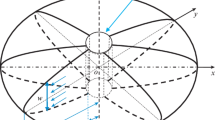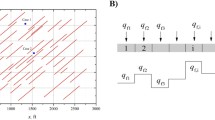Abstract
At present, the hydraulic fracture technologies are widely used for intensification of oil and gas recovery from reservoirs with hard-to-recover reserves. The simulation of the processes of flow through porous reservoirs with hydraulic fractures is fairly completely developed in the steady-state flow approximation. Unsteady processes of pressure distribution are considered with reference to the theory of hydrodynamic methods of investigations of wells in which asymptotically limited intervals of variations in the coordinates and time, i.e., the distances of the order of the well radius and time much smaller than the characteristic time of the process of flow through the porous medium, are considered. At the same time, in the reservoirs with hard-to-recover reserves (low-permeability reservoirs and high-viscosity oils) the duration of the unsteady processes of pressure redistribution can be of the same order as the characteristic time of flow through the reservoir. In the present study new analytical solutions of the problem of unsteady pressure redistribution in the neighborhood of a well penetrated by a vertical fracture are given. The scientific novelty of the study consists in the fact that, firstly, the fluid compressibility in the fracture and, secondly, the fluid flow not only through the fracture but also through the porous reservoir are taken into account in the model used. The solutions of the problems are constructed using the Laplace transform technique. In particular cases, the expressions well-known in literature follow from the solutions obtained. The analytical solutions obtained which makes it possible to determine the main characteristic features of the processes of flow through a porous medium are analyzed.
Similar content being viewed by others
References
Kanevskaya, R.D., Matematicheskoe modelirovanie razrabotki mestorozhdenii nefti i gaza c primeneniem gidravli-cheskogo razryva plasta (Mathematical Simulation of Oil and Gas Field Development Using Reservoir Hydraulic Fracture), Moscow: Nedra-Biznestsentr, 1999.
Cinco-Ley, H. and Samaniego, V.F., Transient pressure analysis for fractured wells, J. Petrol. Techonol., 1981, vol. 33, no. 9, pp. 1749–1766.
Wong, D.W., Harrington, A.G., and Cinco-Ley, H., Application of the pressure-derivative function in the pressure-transient testing of fracture wells, Paper SPE 13056, SPE formation Evaluation, 1986, pp. 470–480.
Nagaeva, Z.M. and Shagapov, V.Sh., Elastic regime of flow through the porous medium in a fracture located in the oil or gas reservoir, Prikl. Mat. Mekh., 2017, vol. 81, no. 3, pp. 319–329.
Asalkhuzina, G.F., Davletbaev, A.Ya., and Khabibullin, I.L., Simulation of differentiation of the reservoir pressure between the injection and producing wells in fields with low-permeability collectors, Vestn. Bashkir. Univ., 2016, vol. 21, no. 3, pp. 537–542.
Khabibullin, I.L., Evgrafov, N.A., and Khisamov, A.A., Simulation of unsteady fluid inflow from a reservoir to a well through hydraulic fracture, in: Proceedings of the First Summer School-Conference “Physicochemical Hydrodynamics: Models and Applications,” Ufa: RITs BashGU, 2016, pp. 184–192.
Earlougher, R.C., Jr., Advances in Well Test Analysis, New York–Dallas: Society of Petroleum Engineers of AIME; Moscow–Izhevsk: Institute of Computing Investigations, 2007.
Khasanov, M.M. and Golovneva, O.Yu., Determination of the production rate of vertical wells with hydraulic fracture of reservoir in the time-dependent regime of flow through the porous medium, Neftyanoe Khozyaistvo, 2016, no. 12, p. 64.
Khabibullin, I.L. and Khisamov, A.A., Simulation of unsteady flow through the porous medium in the neighborhood of a well with a vertical hydraulic fracture, Vestn. Bashkir. Univ., 2017, vol. 22, no. 2, pp. 309–314.
Khabibullin, I.L. and Khisamov, A.A., Theory of the bilinear regime of flow through a porous medium in reservoirs with hydraulic fractures, Vestn. Bashkir. Univ., 2018, vol. 23, no. 4, pp. 958–963.
Doetsch, G., Anleitung zum Practischen Gebrauch der Laplace–Transformation und der Z–Transformation, Munchen, Wien: R. Oldenbourg, 1967; Moscow: Nauka, 1971.
Ditkin, A.V. and Prudnikov, A.P., Operatsionnoe ischislenie (Operational Calculus), Moscow: Vysshaya Shkola, 1975.
Basniev, K.S., Dmitriev, N.M., Kanevskaya, R.D., and Maksimov, V.M., Podzemnaya gidromekhanika (Underground Hydrodynamics), Moscow–Izhevsk: Institute of Computer Investigations., 2006.
Fikhtengol’ts, G.M., Kurs differentsial’nogo i integral’nogo ischisleniya (A Course of Differential and Integral Calculus), Moscow: Nauka, 2003, vol. 2.
Author information
Authors and Affiliations
Corresponding authors
Additional information
Russian Text © The Author(s), 2019, published in Izvestiya RAN. Mekhanika Zhidkosti i Gaza, 2019, No. 5, pp. 6–14.
Rights and permissions
About this article
Cite this article
Khabibullin, I.L., Khisamov, A.A. Unsteady Flow through a Porous Stratum with Hydraulic Fracture. Fluid Dyn 54, 594–602 (2019). https://doi.org/10.1134/S0015462819050057
Received:
Revised:
Accepted:
Published:
Issue Date:
DOI: https://doi.org/10.1134/S0015462819050057




